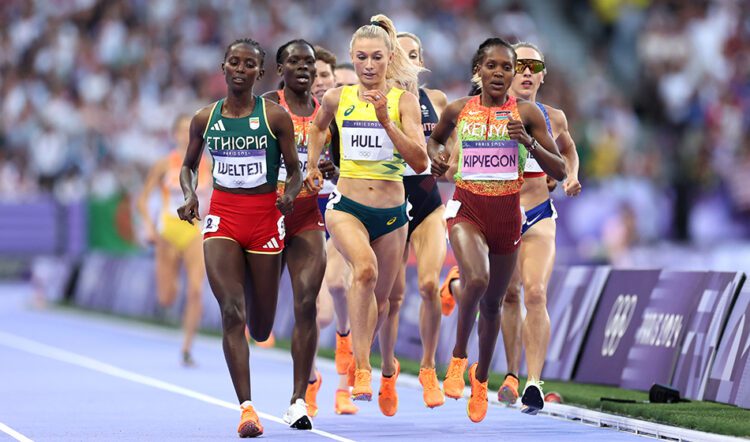Australian middle-distance runner on why Faith Kipyegon’s approach is driving standards and creating a “special time” in women’s running
Jessica Hull recalls the moment she stood on the podium in Paris, a silver medal draped around her neck and the roar of the crowd still ringing in her ears after the 1500m final. Beside her was Faith Kipyegon, receiving her third consecutive gold in the event – hailed as the greatest middle-distance female runner of all time. For the Australian, there was a surreality to what was happening. The same athlete she had once admired from afar on her television screen was now standing right next to her.
“It was a pinch-yourself moment,” says Hull. “It’s a moment that you dream of and you try to set yourself up to be ready for it. But, when it actually happens, it’s incredibly special.
“We’re not short of role models in our sport but, having watched Faith succeed for so long and to be able to share that success with her, was amazing. When I look back at my younger self, the one who used to watch Faith winning Diamond Leagues, there’s no way she’d have believed we’d one day be standing on the same Olympic podium.”
For Hull, belief didn’t come out of nowhere. It grew gradually, through hard work and careful training. She didn’t just rely on hope – she built her confidence by putting in the miles, improving her race strategies and working on her weaknesses.
In the past year, the 28-year-old has focused on getting stronger in every part of her running, especially expanding her ability to compete across different distances. During the Grand Slam Track series, she has taken on both the 800m and 1500m, pushing herself to become what she calls a “true middle-distance runner”.
“It’s been really fun to focus on both ends,” she explains. “The 800m is not an area that I’ve been super comfortable in previously, but I’ve had to learn, to adjust, and now I’m also seeing it pay off in my 1500s.”

The work is clearly paying dividends, given her 1:58.58 800m PB in Kingston, and those advances are timely. This year, in the middle-distance world, the stakes feel higher. The pace is faster. The atmosphere is electric. The main cause of that is Kipyegon, who is now on a mission to break the four-minute mile.
“When I heard she was going for it, I thought: ‘If anyone can do it, it’s Faith,” Hull says. “But more than that, it was like... wow. She’s done everything. She didn’t have to chase this. And yet, here she is, still pushing the limits.
“She’s done everything. She’s broken world records. She’s won Olympic gold three times. She’s won World Championships. So what excites her and keeps that fire going is attempting sub-four and that is what is really special to see – an athlete that has done everything, finding a new way to get some inspiration and keep improving the sport.”
Kipyegon’s attempt to become the first woman to run a mile in under four minutes isn’t just a quest for a record. It’s a statement. A cultural moment. It challenges long-held ideas about what women can achieve in distance running. It’s pushing against limits.
“I think it’s changing the whole sport,” Hull says. “It’s forcing us all to think bigger.”

And Hull would know. In Monaco two years ago, when Kipyegon ran her mile world record 4:07.64, Hull was in the race – eight seconds behind, but still running the fastest mile of her life, clocking an Oceania record of 4:15.34. “She obliterated us in the field that night,” she recalls. “And you look at that and think, if she had pacers with her the whole way, people to run with her to the finish, then there’s definitely more in the tank.”
What strikes Hull most isn’t just the attempt itself, but what it represents for women’s athletics. In a sport where barriers often carry both physical and symbolic weight, the idea of going under four minutes in the mile has long felt out of reach. Kipyegon is tackling that perception head-on.
“It has raised the bar,” says Hull. “It has raised the opportunity for conversations about how fast women can run.
“It sends this message that you don’t really know what’s possible until you try. I think her whole career has followed that [approach] by the way she wins races, the way she fights to the line and by the way she’s dominated in the last five years.
“She has been a super talent and an inspiration to all of us athletes. It almost feels like we owe her something in return for the level that she has pulled us all to. She’s passed the gauntlet down to us to improve, to get better and to think bigger.”

Hull isn’t alone in feeling the shift. Ask any top middle-distance female runner and they’ll tell you the same thing: something is changing. There’s a momentum in the women’s field that feels unprecedented.
“We haven’t seen an era like this in a very long time,” Hull says. “There’s Keely [Hodgkinson] dominating the 800m and threatening world records. You have Faith who can break a world record in the 1500m, the mile, and the 3000m and 5000m if she really wants to. You then have athletes like Beatrice Chebet in the longer distances and [Winfred] Yavi in the steeplechase. The talent at the top is incredible.
“It’s a pretty awesome time to be a female middle distance runner. There’s inspiration wherever you look from, whether it’s by the way someone races, the way someone trains or by the way someone approaches things with their mindset.”
For Hull, it’s more than exciting – it’s personal. She’s in the mix, evolving, adapting and growing in belief with every passing season.
“It’s almost become a habit,” she says. “If they are all improving, then I can improve, too.”

While breaking the four-minute mile would be an historic moment on its own, Hull is more struck by the effort it takes to even line up for such an attempt. For her, what sets Kipyegon apart isn’t just her speed – it’s the level of commitment that most people don’t see. The months of preparation, the punishing training sessions at altitude, the relentless focus on every detail. Hull knows first-hand how much goes into a peak performance, and she can only imagine the intensity of the work behind the scenes.
“I’ve thought about what it would take in terms of the sessions that I would need to do and the splits I would need to hit to be able to have the confidence to attempt that kind of thing and it’s very daunting,” she says.
“She’s training in Nairobi, 2000m in the air and that is challenging enough in itself. If you think about the lifestyle she has probably been living these last couple of months with everything focused on that sub-four attempt, there will be big waves of fatigue I'm sure she is experiencing.”
Hull would love to see the behind-the-scenes reality broadcasted alongside the attempt. “I hope they show some of that,” she says. “The months that have gone into it will put a whole new-found perspective and appreciation on the attempt and bring it to life. It will humanise the effort that she is making and it’s a good way to give outside watchers an insight into what has really gone into the big time milestone attempt.”
From watching Kipyegon as a teenager to racing her in Olympic finals, Hull has been both an observer and competitor.
“Faith leads by example but she wants you to succeed as well,” Hull says. “I remember in Florence when she broke the world record [3:49.11 in 2023] – I came eight seconds behind [3:57.29] and broke the Australian record. And before I could even congratulate her, she turned around and congratulated me on something so miniscule compared to what she had just done and been attempting to do for years.”

Hull credits Kipyegon, and also Laura Muir, as key figures in shaping her own path. “They’ve both been big influences on my career,” she says. “To have shared some really big moments and some celebrations at the finish line with those two athletes have been key moments that I will treasure forever.”
Despite all the inspiration, Hull is clear: she’s not looking to be a part of the sub-four herself – at least not yet.
“It’s not on my radar right now,” she says. “If there’s an opportunity at a different point in time that fits my schedule then I’d absolutely be there. Whether that’s at trackside to support or to participate a couple of steps back. But, this year, my race commitments mean I can’t be there on the day but I’ll be watching with great excitement and crossing my fingers and cheering for her.”
Hull’s own season is still very much in motion. She’ll finish the Grand Slam series in Los Angeles before hitting the Diamond League circuit in July. Her summer will include the Prefontaine Classic, Monaco Diamond League and, she hopes, the Diamond League final – all in preparation for the next big goal: another international medal at the World Championships in Tokyo.
Hull is learning what it means to stay at the top. It’s a lesson in consistency, and one she’s taking seriously.
“I want to be really consistent and at the top of the sport,” she says. “I feel like I’ve worked really hard to build my way here and now I want to be consistently making podiums.”

She’s already showing the capability to do that. Her bronze medal in the 3000m at the World Indoor Championships marked another step forward – an upgrade from her fourth-place finish in Glasgow the year before, and a sign of real progression.
“It was a good little stepping stone,” she says. “It was nice to pick up some hardware as my main goal was to get on the podium. Coming off the summer, I really wanted to emphasise that I belonged on the podium so I was very proud of it.”
But staying at the top comes with its own pressures, that Hull is still learning how to carry. The expectations aren’t just from others – they’re often her own.
“You set a goal like: ‘I want to leave Tokyo with a medal,’ and there’s a lot of steps along the way but you really can’t be overwhelmed by that big goal,” she says. “You win a medal or you don’t.
“But it’s an opportunity to take that [Olympic] silver medal and use it as encouragement. Sometimes it’s your own expectations that are the hardest ones to meet but you’ve got to have big goals and that’s what keeps you turning up at the track each day.”
Hull is honest about the challenges that come with those ambitions, but also about the joy in chasing them.
“It’s been fun to learn how to embrace being a silver Olympic medallist and sometimes there are challenges because your goals are so high,” she continues. “Last year, I enjoyed the process of becoming a silver medallist and I gained momentum as the season went on. It’s really important not to become too focused on the outcome of the end of the season. It’s been something that I’ve had to dance around and learn to embrace but it’s been really fun.”
Now, as she prepares for the next part of her season, Hull does so in the sport where women are pushing boundaries not just in performance, but in possibility.
“It’s now a very special time. Faith is the best person to be embodying what the message of attempting a sub-four attempt mile is, which is to never put a limit on what’s possible because you never know until you try.”
